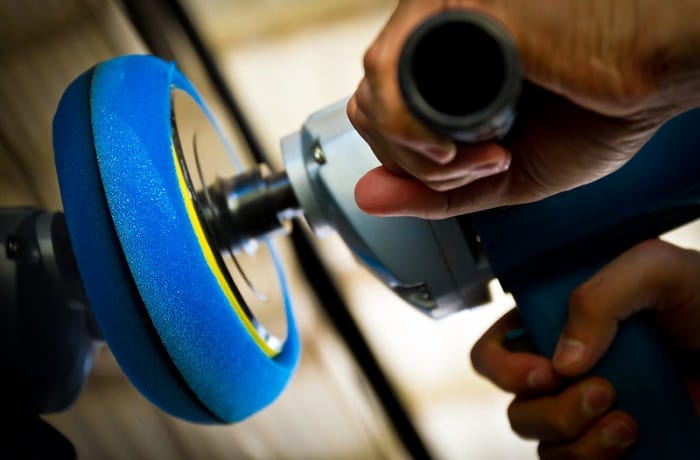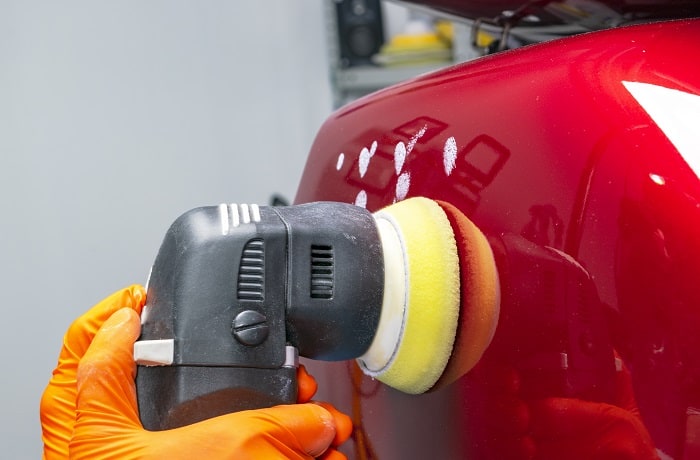Buffing is an efficient way of polishing your car, more so if you are interested in removing defects on your car’s finish. There are two things you can use when buffing a car; either go with a microfiber towel or a buffing pad.
The latter is mostly used by professionals because of its ability to hold polish evenly and ensure a thorough application.
Buffing pads are also becoming very popular amongst car owners as they perform DIY detailing jobs on their cars.
Buffing pads come in a variety of colors. These colors are used to differentiate the role that is supposed to be carried out by each pad.
If you have bought buffing pads and are wondering what the color difference means, here is a breakdown of the different color pads, their strengths, and their purposes.

Table of Contents
- Buffing Pad Color Chart
- Should You Use Different Pads for Different Color Vehicles?
- Why Do Buffing Pads Have Different Colors?
- Do Polishing and Buffing Pads Have the Same Color?
- Do All Color Buffing Pads Last the Same?
- Do You Need All Buffing Pad Colors?
- Why You Should Always Clean Your Buffing Pads?
- How are Buffing Pads Made?
- How Do The Different Color Buffing Pads Work?
Buffing Pad Color Chart
• Yellow Buffing Pad
This is the most aggressive buffing pad that should be used to polish old and heavily oxidized finishes.
The yellow buffing pad, other than removing excess oxidation, is exceptionally ideal for getting rid of water spots and scratches.
The yellow buffing pad should be used first followed by an orange pad to give your car a finer finish.
• Orange Buffing Pad
The orange buffing pad is a fine high-density foam that does an excellent job of removing defects and scratches on your car’s finish. It offers paint correction while polishing your car at the same time.
Depending on how heavy your compound is, an orange buffing pad can help remove scratches or swirl marks without leaving behind a haze. This should be your go-to pad for moderate to slight imperfections.
• Green Buffing Pad
If you are planning on applying a one-step polish or cleaner wax then this is the buffing pad you should use. A green buffing pad features a unique compression ratio which allows it to conform easily to contours.
This pad also produces limited spot heating. You can use green buffing pads to remove scuffs and swirls. You can also create a balance between finishing and polishing with the green buffing pad.
• White Buffing Pad
Featuring a less dense formula, this is the pad you should use when applying micro-fine sealants, polishes, and cleaner waxes. What makes it ideal for pre-wax cleaners is its light-cutting powers.
• Red Buffing Pad
For car owners with sensitive paint finishes, this should be the pad to use when applying sealants and waxes.
The red buffing pads have an ultra-soft composition which makes them perfect for light polishing and waxing jobs.
• Black Buffing Pad
These have always been used in the final finishing process to remove swirls on your car paint. From the way it has been designed, black buffing pads have a firm composition that allows them to withstand a lot of pressure because they have no cut, which you can use to apply even coats of glazes, waxes, and sealants.
• Blue Buffing Pad
Do you crave a super fine finish? Then focus all your buffing efforts on the blue pads. These pads boast a unique composition that complements all light surfaces and glazes to create an impressive finish.
To help you understand better the role these different color buffing cards play in polishing your car, here is a quick summary.
Yellow is a heavy cutting pad, orange is a medium-heavy cutting pad, green is a heavy polishing pad, white is a medium-light polishing pad, blue is a glazing pad, black is a finishing pad and finally, red is for a perfect ultra-fine finishing pad.
Now that you are aware the difference in colors you see on buffing pads is associated with the purpose and not just aesthetics. Let’s dive deeper into buffing pads and their colors.

Should You Use Different Pads for Different Color Vehicles?
This is a very reasonable concern that any car owner should have. Because color buffing pads have different colors, should I use different pads for different color vehicles?
All buffing pads are fabricated to do their job irrespective of a car’s paint job. Whether you have a black car or a red-painted one, follow the above color chart when polishing, waxing, or applying a sealant to your car.
Also, when it comes to using buffing pads on your car, the current status of your paint should be the determining factor, not the color.
On soft paint, you should use a medium polishing pad. Whereas if your car paint has heavy oxidation, you are better off using a more aggressive buffing pad.
Why Do Buffing Pads Have Different Colors?
The car detailing world can come off as complex especially if you aren’t well acquainted with it. However, it’s quite simple. There are a lot of things associated with buffing and polishing.
Some cars require aggressive buffing so that they can look better, whereas others require a soft touch.
Because of these differences, manufacturers decided to use different color pads so that detailers could distinguish which pad should be used where, and why.
Yellow pads are often used for cars that need serious buffing. Black pads on the other are used for finishing.
Sensitive car paints require softer pads such as the red ones. For every colored pad, it serves its purpose.
Do Polishing and Buffing Pads Have the Same Color?
To answer this question correctly, allow me to differentiate between the two. Buffing aims to remove lines and create a brighter finish whereas polishing generates a lined finish.
In general, pads can be used for buffing or polishing. It depends on the product you are using to get your desired result.
If you want to polish your car, you will then have to buy a car polish and use a polishing pad for application and vice versa.
Polishing is more aggressive when compared to buffing. Irrespective of which type of detailing you plan to do, you should stick to the pad color chart described above.
Do All Color Buffing Pads Last the Same?
If used equally, all buffing pads irrespective of their color are designed to last for the same period. That is, between 75k to 100k square feet of car surface per pad.
However, because not all pads will be used equally either when polishing or buffing, chances are, one will wear out before another does.
Do You Need All Buffing Pad Colors?
This will depend on your car’s buffing needs. In my opinion, I would get all buffing pad colors because these pads aren’t just used once, you can buff up to 100k square feet of a car’s surface with one pad.
With all colors in your possession, you can perform various buffing and polishing jobs on your car depending on the state of your paint job.
Whenever your car requires heavy buffing, the yellow polishing pad will be there to save the day. And if you just want to get rid of light scratches, then the green buffing pad can be used.
As you shop for buffing pads, you need to assess the state of your car’s paint and choose colors that will help you achieve your desired results.
Why You Should Always Clean Your Buffing Pads?
Having fully understood the different color buffing pads that exist, and the role each has. What you need to know next is how to use and take care of your buffing pads.
To kick things off, let’s start with buffing pad care. As mentioned earlier, buffing pads can serve your car for an extended period. So, irrespective of the color you are using, you need to know how to clean it.
A cleaner pad will always work better than a dirty one. As you polish or buff your car, tiny bits of polishing compound get stuck in between the pad and if not cleaned, these can affect the pad’s ability.
To ensure your buffing pads offer years of reliable service, clean them regularly.
How are Buffing Pads Made?
Depending on the purpose a certain pad is designed to offer, it is made with materials such as foam or wool. The likes of yellow pads that are aggressive are made from stronger materials that can buff through oxidized car surfaces.
All pads are made with two materials, there is the material at the end which makes contact with the paint. Then there is the holding material that allows the pad to stick to the backing plate of a polisher.
The foam at the end easily absorbs polishes and other compounds for application purposes.
How Do The Different Color Buffing Pads Work?
Each buffing pad is formulated to work in its unique way. All of them hold the abrasive particles in polishes and other compounds. And they also conform easily to curved surfaces.
Depending on the color of the pad, the material used to construct it is often designed to interact differently when it comes into contact with car paint and other surfaces.
The material used determines the level of friction and heat produced during polishing or buffing.
